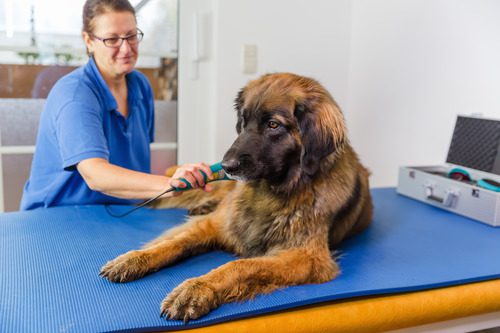Arthritis in Dogs: Signs to Watch for and How Laser Therapy Can Help
Arthritis in dogs is more common than many pet owners realize, and it can have a big impact on a dog’s comfort and quality of life. Spotting the signs early and exploring treatment options can make a world of difference. One therapy that has gained attention in recent years is laser therapy, a non-invasive approach that can provide real relief. If you’ve noticed your dog slowing down, struggling with mobility, or showing other signs of arthritis in dogs, this blog will guide you through what to look for and how laser therapy at Best Friends Veterinary Care may help.

Understanding Arthritis in Dogs
Arthritis in dogs refers to inflammation of the joints, which often results in stiffness, pain, and reduced mobility. It is especially common in older dogs, but it can also affect younger dogs due to injury, genetics, or certain health conditions.
Common Causes of Arthritis in Dogs
- Age-related wear and tear: Older dogs are more likely to experience joint deterioration over time.
- Genetics: Some breeds are more prone to joint issues, including Labrador Retrievers, German Shepherds, and Golden Retrievers.
- Injury: Previous injuries or joint surgeries may increase the risk.
- Obesity: Extra weight puts more pressure on a dog’s joints, accelerating degeneration.
- Developmental conditions: Hip dysplasia and elbow dysplasia are major contributors to arthritis in dogs.
Arthritis can progress gradually, which makes it easy for owners to overlook the signs until the condition worsens.
Signs of Arthritis in Dogs to Watch For
Dogs often hide discomfort, so spotting arthritis in dogs requires close attention. These signs may indicate joint pain or stiffness.
Physical Signs
- Limping or favoring a leg after rest or activity
- Difficulty climbing stairs or jumping onto furniture
- Slower movement, especially in the morning or after naps
- Stiffness that improves as they “warm up”
- Swelling around joints
Behavioral Signs
- Reluctance to play or go for walks
- Irritability or changes in mood
- Restlessness or difficulty settling down
- Decreased interest in activities they once enjoyed
- Vocalizing when moving, such as whining or whimpering
If your dog shows one or more of these signs, arthritis could be the reason.
How Arthritis in Dogs Affects Quality of Life
Living with arthritis in dogs doesn’t just mean physical discomfort. It can also affect your dog’s overall happiness and day-to-day behavior. Dogs with arthritis often become less social, show less interest in family activities, and may even become anxious when movement causes pain. Because dogs rely on mobility to explore, play, and interact, arthritis can dramatically change how they experience the world.
Laser Therapy as a Treatment Option for Arthritis in Dogs
Veterinarians often recommend multimodal treatment approaches for arthritis in dogs, and laser therapy has become a valuable addition. It is non-invasive, drug-free, and can be used alongside other veterinary care options.
How Laser Therapy Works
Laser therapy, also called cold laser therapy or photobiomodulation, uses specific light wavelengths to penetrate tissues. This stimulates cell activity and increases blood circulation, which can:
- Reduce inflammation
- Decrease pain
- Promote healing at the cellular level
- Improve joint function
Because laser therapy does not require anesthesia or incisions, dogs can comfortably receive treatment during a short, in-clinic visit.
Benefits of Laser Therapy for Dogs with Arthritis
Laser therapy provides multiple benefits that support dogs living with arthritis.
Pain Relief
Laser energy stimulates natural pain-relieving chemicals in the body, helping dogs feel more comfortable without invasive procedures.
Improved Mobility
By reducing stiffness and inflammation, laser therapy helps dogs move more freely. Many owners report seeing their dogs regain interest in walking, playing, and climbing stairs.
Enhanced Healing
Laser therapy promotes tissue repair, which may help slow the progression of arthritis in dogs.
Safe and Non-Invasive
Since laser therapy is non-invasive, it is safe for most dogs and can be repeated as part of a long-term arthritis management plan.
What to Expect During a Laser Therapy Session
A typical laser therapy session for arthritis in dogs is quick and stress-free.
During the Appointment
- Dogs are usually positioned comfortably on a padded surface.
- A handheld laser device is applied over the affected joints.
- Sessions often last between 5–20 minutes, depending on the number of joints treated.
- Most dogs relax during the treatment, and some even fall asleep.
Frequency of Treatments
At first, multiple sessions per week may be recommended to build momentum in reducing pain and inflammation. Over time, the frequency is reduced as dogs respond to treatment and show improvement.
When to Consider Laser Therapy for Your Dog
Laser therapy is not limited to senior pets. Dogs of various ages with arthritis or joint pain may benefit. You may want to discuss laser therapy with your veterinarian if your dog:
- Has been diagnosed with arthritis
- Struggles with daily mobility tasks
- Shows signs of chronic pain or stiffness
- Needs a non-invasive option to manage joint discomfort
Laser therapy is often used as part of a broader treatment plan that may include weight management, supplements, or other veterinary-recommended options.
Helping Your Dog Live Comfortably with Arthritis
Arthritis in dogs can be challenging, but support is available. By recognizing the signs early and exploring options like laser therapy, you can help your dog feel more comfortable and stay active longer. If you’ve noticed your dog slowing down or showing symptoms of arthritis in dogs, Best Friends Veterinary Care in Nesconset, NY, can help. Call 631-656-5990 or book an appointment online today to discuss whether laser therapy may be right for your pet.
About Us
Best Friends Veterinary Care warmly welcomes you to our animal hospital in Nesconset, where we provide exceptional care for your pet and outstanding service for you and your pet. With longer appointment times, our team of experienced veterinarians offer their undivided attention and top-notch treatment for your pet during each visit to our hospital.
